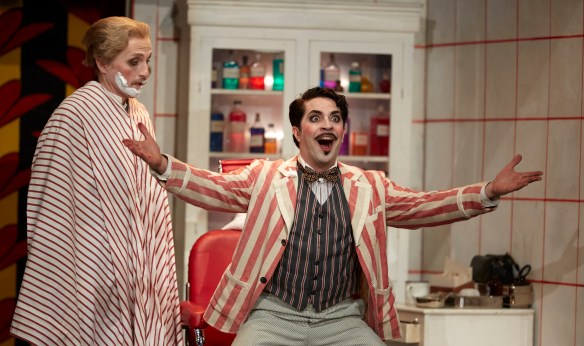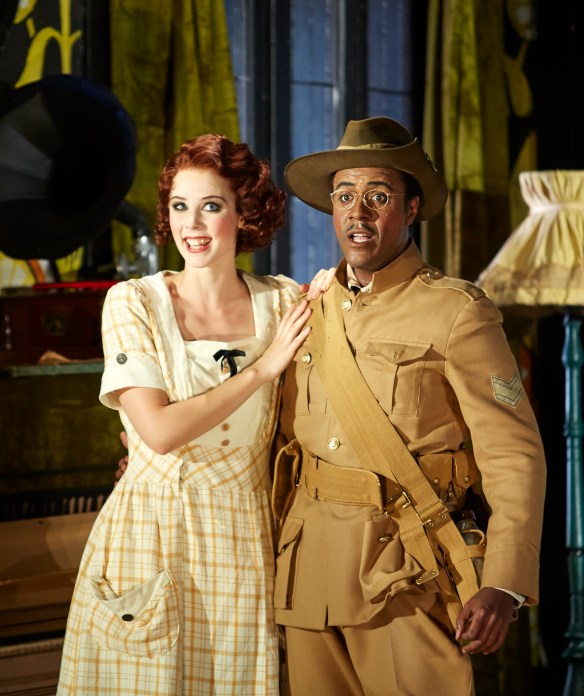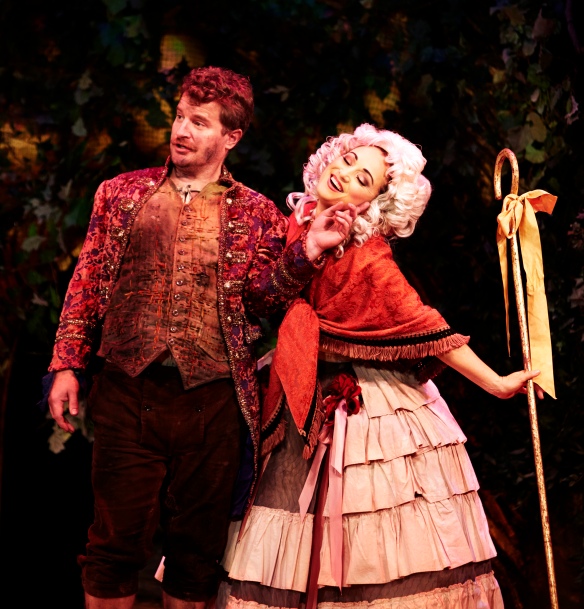Fleet Steps, Mrs Macquarie’s Point, March 24
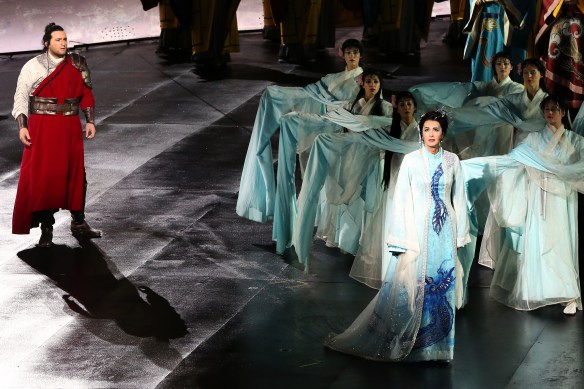
Riccardo Massi and Dragana Radakovic. Photo: Prudence Upton
Spectacle is a pre-requisite for Opera Australia’s Handa Opera on Sydney Harbour – and Turandot doesn’t disappoint, offering plenty of visual thrills without resorting to tacky glitziness. Nor does it ever feel that the stage is full of colour and movement just for the sake of it.
What’s more, with Dragana Radakovic as Turandot and Riccardo Massi as Calaf, the production is led by principal singers who are able to command the huge space with their magnetic presence and powerhouse vocals.
Set in a fantasy China, Puccini’s final (and unfinished) opera tells a barbaric tale. Turandot, the ice-cold princess, demands that her suitors are beheaded if they fail to answer three riddles. The score includes many glorious melodies (some of which draw on Chinese tunes) and, of course, the well-known aria Nessun dorma.
Given the one-dimensional stereotyping of Asian women in Turandot and Puccini’s Madama Butterfly, Chinese-born New York-based director Chen Shi-Zheng has knocked back many offers to direct both operas, but allowed himself to be talked into it now by OA artistic director Lyndon Terracini.
In interviews, Chen has said that he aims to present Princess Turandot as a more complex and believably human figure, while also seeing her as an embodiment of China with its centuries-old suspicion of the West.
Whether he achieves that is debatable. Despite a superb performance from Radakovic, Turandot (who explains in an Act II aria why she hates the foreign princes who come to woo her) doesn’t really come across as any more nuanced a character than usual.
Be that as it may, Chen’s production tells the story with great clarity. He uses the vast stage well and is adept at ensuring the focus is where it needs to be.

The Turandot set with fire-breathing dragon. Photo: Prudence Upton
Dan Potra’s design is dominated by two major set pieces. On one side there is a giant, fire-breathing dragon whose tail suggests the Great Wall of China onto which images are projected. There’s also a towering pagoda studded with sharp spikes resembling dragon scales, from where Turandot looks down on the world below. The tower has a (wobbly) drawbridge on which she gradually descends with each riddle that Calaf guesses correctly.
The dragon imagery extends to Turandot’s gorgeous, shimmering silvery white and blue gown. Potra’s costuming makes clever use of colour, pattern and sparkle without over-doing it, while Scott Zielinski’s dramatic, coloured lighting creates many stunning effects. The one design element that looks odd is the Emperor’s throne, which moves through the air on a crane like a gigantic flying sofa.
Handa Opera on Sydney Harbour is now in its fifth year and fireworks have become an expected feature. Turandot doesn’t offer many obvious moments for their inclusion so they explode after Nessun dorma. It’s not ideal but given the audience’s rapturous response to that most famous of arias it works OK, though keeping them to the end might have been better.
Chen has also done the choreography, which draws on martial arts for the guards, while Turandot’s female attendants glide around the stage, sending their billowing sleeves flying through the air. As with his direction, the movement serves the story and production beautifully.
Radakovic, a Serbian dramatic soprano, is an impressive, imperious Turandot with an exciting, powerful voice that has a glinting, steely quality at times, which suits the character.
Massi is magnificent as Calaf. The Italian tenor is a tall man, giving him a commanding, heroic presence. He exudes enormous charisma and warmth, matched by his beautiful, rich, burnished voice. In a sensitive rendition of Nessun dorma he builds the aria perfectly, bringing the house down as he soars to the climactic top B.
(The production features two alternating casts, with Daria Masiero as Turandot and Arnold Rawls as Calaf heading the other).
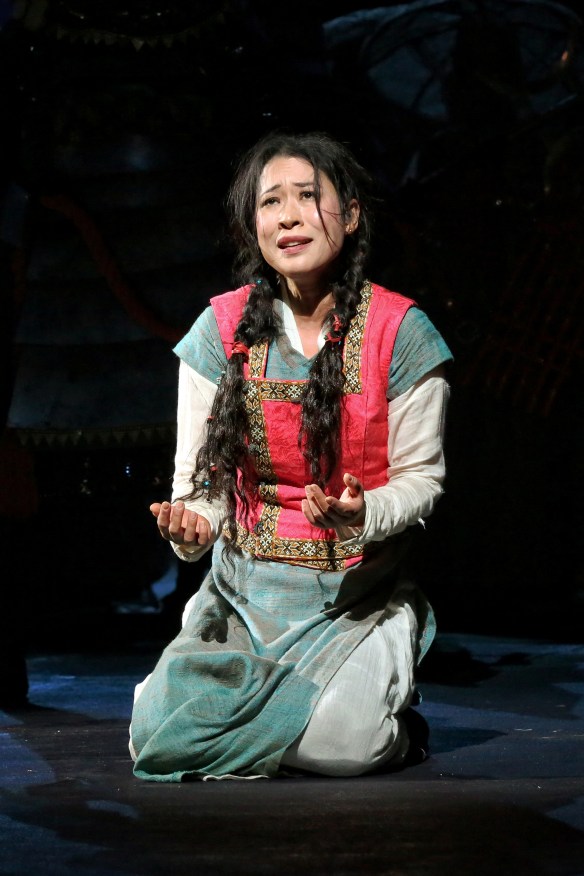
Hyeseoung Kwon as Liu. Photo: Prudence Upton
Liu, the slave girl who secretly loves Calaf, is at the emotional heart of the opera. Hyeseoung Kwon who has sung the role previously for OA is heartbreaking. She sings with a moving lyricism, while portraying the character with more strength and resolve than is often the case. Her torture has you wincing and her suicide is very moving.
There is terrific work from Luke Gabbedy, Benjamin Rasheed and John Longmuir as the comic courtiers Ping, Pang and Pong who have plenty of choreography to negotiate while singing. Conal Coad as the blind Timur, David Lewis as the Emperor and Gennadi Dubinsky as the Mandarin all offer strong support, while the chorus is marvellous.
The Australian and Ballet Orchestra, conducted by Brian Castles-Onion, gives a fine account of the score and while you are always aware of the amplification, Tony David Cray’s sound design is clear.
With its combination of spectacle, clear story-telling and superb singing, Turandot should appeal to both regular opera-goers and newcomers. Having Chinese as well as English surtitles is also an astute move as OA seeks to broaden the audience for what has become a key event on Sydney’s arts calendar.
Turandot: Handa Opera on Sydney Harbour, Fleet Steps, Mrs Macquarie’s Point; until April 24. Bookings: 02 9318 8200, opera.org.au/Harbour
A version of this review ran online for Daily Telegraph Arts

